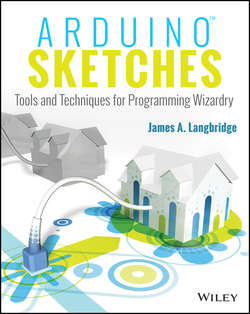Читать книгу Arduino Sketches - Langbridge James A. - Страница 10
На сайте Литреса книга снята с продажи.
Part I
Introduction to Arduino
Chapter 1
Introduction to Arduino
Atmel AVR
ОглавлениеAtmel is an American semi-conductor company, founded in 1984, and the name Atmel is an acronym for Advanced Technology for Memory and Logic. Right from the start, Atmel designed memory chips that used less power than competing designs, but it soon decided to create programmable devices. In 1994, Atmel entered the microprocessor market, creating an extremely fast 8051-based microcontroller. In 1995, Atmel was one of the first companies to license the ARM architecture, giving it access to advanced processor technology.
Atmel didn't use only ARM technology, it also created its own processor, the AVR, in 1996 (see Figure 1.2). What does AVR stand for? Well, that is one of the many mysteries of Atmel. Designed by Alf-Egil Bogen and Vegard Wollan, some say it stands for Alf and Vegard's RISC processor. We will never know, and at the time, people were not interested in understanding the name, but rather getting their hands on this advanced piece of technology. Today, more and more people are curious as to the origin of this curious processor, Atmel continues to tease the public with videos of the inventors explaining the name, only to have the big reveal scrambled by mobile telephone interference.
Figure 1.2 Atmel AVR Microprocessor
Previously, programming the read-only memory of a device required some tedious tasks, like subjecting the chip to UV light, or complicated erase techniques. This all changed with Atmel's 8-bit AVR. The AVR was the first microcontroller family to use on-chip flash memory for program storage. It also included Random Access Memory (RAM) directly on the chip, essentially containing everything needed to run a microcontroller on a single chip. Suddenly, all the complicated design could be replaced with a single component. Even better, programming the chip could be done in minutes, using minimal hardware. Some Atmel designs allowed users to plug the microcontroller directly into a USB port and to program it using Atmel's software. From compilation to program execution took less than a minute.
Several learning platforms existed: Parallax's BASIC Stamp and PIC devices were in use, but Atmel's AVR made its appearance and added another alternative for electronics enthusiasts. Previously, on digital systems, the logic was defined before creating the board. Inputs and outputs were connected to logic gates, and the functionality was designed into the product. Now, with the AVR series, enthusiasts and engineers had a new possibility. Instead of designing functionality electronically, systems could be designed to interact with the outside world using computer programming. This simplified electronics; instead of using multiple logic gates, everything was connected directly to the microcontroller, which could then be programmed to react to events from the outside world. Programs could be flashed and re-flashed, and devices could be programmed and re-programmed, opening the gates to a whole new world of electronics. In theory, a device could be made that would adapt to almost every situation possible. The technology existed; all that was left was for someone to create the device.
